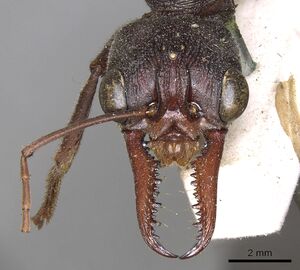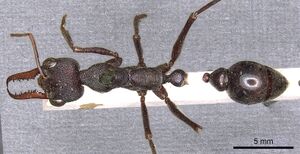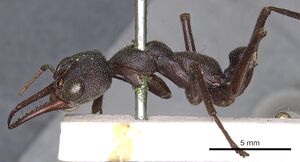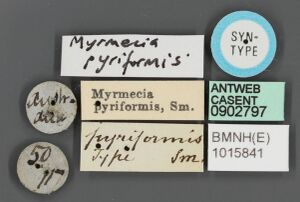Myrmecia pyriformis
| Myrmecia pyriformis | |
|---|---|

| |
| Scientific classification | |
| Kingdom: | Animalia |
| Phylum: | Arthropoda |
| Class: | Insecta |
| Order: | Hymenoptera |
| Family: | Formicidae |
| Subfamily: | Myrmeciinae |
| Tribe: | Myrmeciini |
| Genus: | Myrmecia |
| Species group: | gulosa |
| Species: | M. pyriformis |
| Binomial name | |
| Myrmecia pyriformis Smith, F., 1858 | |
| Synonyms | |
| |
Myrmecia pyriformis is a nocturnal forager whose activity outside the nest is largely restricted to night. Most foragers make only one foraging journey per night, leaving the nest individually at dusk to forage on nest-specific Eucalyptus trees. The majority of foragers return to the nest in the morning twilight, but individuals who capture prey often make multiple trips during the night. Foragers imbibe liquid food while abroad and likely share these resources via trophallaxis once within the nest. (Reid et al., 2013; Narendra et al., 2013)
Colonies can have either a normal, dealate queen or survive without a morphological queen (Dietemann et al., 2004). When the queen is absent a few mated workers are able to reproduce and maintain the colony (i.e. (gamergates). A colony collected without a queen continued to produce workers for the next three years (Sanetra, 2011). Queens generally mate with multiple males, estimated to be 2.6 on average. When gamergates are present, there are generally more than one (Sanetra, 2011).
| At a Glance | • Gamergate |
Photo Gallery
Identification
Keys including this Species
Distribution
Latitudinal Distribution Pattern
Latitudinal Range: -27° to -39.91667°.
| North Temperate |
North Subtropical |
Tropical | South Subtropical |
South Temperate |
- Source: AntMaps
Distribution based on Regional Taxon Lists
Australasian Region: Australia (type locality).
Distribution based on AntMaps
Distribution based on AntWeb specimens
Check data from AntWeb
Countries Occupied
| Number of countries occupied by this species based on AntWiki Regional Taxon Lists. In general, fewer countries occupied indicates a narrower range, while more countries indicates a more widespread species. |

|
Estimated Abundance
| Relative abundance based on number of AntMaps records per species (this species within the purple bar). Fewer records (to the left) indicates a less abundant/encountered species while more records (to the right) indicates more abundant/encountered species. |

|
Biology
Myrmecia pyriformis is a nocturnal forager. Most foragers make only one foraging journey per night, leaving the nest individually in a narrow light-window in the evening twilight to forage on nest-specific Eucalyptus trees. The majority of foragers return to the nest in the morning twilight, while few attempt to return to the nest throughout the night (mainly those that are returning with prey). Activity during the night varies with moon illumination, likely due to changes in light levels which influence navigation to and from the nest. As light levels drop, ants pause for longer, walk more slowly, the success in finding the nest is reduced and their paths became less straight. In both bright and dark conditions ants rely predominantly on visual landmark information for navigation and landmark guidance becomes less reliable at low light conditions. It is likely that poor navigational efficiency at low light levels cause the majority of foragers to restrict navigational tasks to the twilight periods, where sufficient navigational information is available (Reid et al., 2013; Narendra et al., 2013)
Colony life history
Wheeler (1916) described a mating flight near Armidale in New South Wales: "As soon as a male (and there were hundreds of males to every female) captured a female on a bush, other males surrounded the couple till there was a struggling mass of ants forming a ball as large as one's fist. As many as half a dozen of these balls would keep forming on every little bush and this went on throughout the morning". After mating, young winged queens found colonies independently in a non claustral manner (Life History). Colonies can grow up to a few thousand workers (Sanetra, 2011).
Association with Other Organisms
 Explore: Show all Associate data or Search these data. See also a list of all data tables or learn how data is managed.
Explore: Show all Associate data or Search these data. See also a list of all data tables or learn how data is managed.
- This species is a host for the eucharitid wasp Austeucharis sp. (a parasitoid) (Quevillon, 2018) (multiple encounter modes; direct transmission; transmission outside nest).
Life History Traits
- Queen number: monogynous
- Queen type: winged or dealate; gamergate
- Colony type: monodomous
- Nest site: hypogaeic
- Diet class: omnivore
- Foraging stratum: arboreal
- Foraging behaviour: solitary forager
- Activity time: nocturnal
- Diet: generalist
Castes
Myrmecia pyriformis workers are markedly polymorphic in size; minor workers are almost half the size of majors. All workers have a spermatheca, and three gamergates (intermediate in body size) were found in one orphaned colony (Dietemann et al. 2004). This is the only record of gamergates in subfamily Myrmeciinae, and they apparently function as replacement reproductives, after death of the founding queen. In a colony collected from Calga, NSW, queens had 33.3±2.1 (n=5) ovarioles, workers had 21.4±5.4 (n=82)(Dietemann et al. 2004). In a colony collected from the campus of Flinders University in Adelaide, one queen had 30 ovarioles, workers had 8-12 (C. Peeters unpublished). This difference in ovariole numbers may indicate that these populations 1200km distant are genetically differentiated.
Images from AntWeb
     
| |
| Syntype of Myrmecia pyriformis. Worker. Specimen code casent0902797. Photographer Z. Lieberman, uploaded by California Academy of Sciences. | Owned by NHMUK, London, UK. |
Phylogeny
| Myrmecia |
| ||||||||||||||||||||||||||||||||||||||||||||||||||||||||||||||||||||||||||||||||||||||||||||||||||||||||||||||||||||||||||||||||||||||||||||||||||||||||||||||||||||||||||||||||||||||||||||||||||||||||||||||||||||||||||||||||||||||||||||||||||||||||||||||||||||||||||||||||||||||||||||||||||||||||||||||||||||||||||||||||||||||||||||||||||||||||||||||||||
Based on Mera-Rodríguez et al. (2023).
Nomenclature
The following information is derived from Barry Bolton's Online Catalogue of the Ants of the World.
- pyriformis. Myrmecia pyriformis Smith, F. 1858b: 144, pl. 10, figs. 1-6 (w.q.m.) AUSTRALIA (Victoria, New South Wales).
- Type-material: 1 syntype worker, 1 syntype queen.
- Type-locality: Australia: Victoria, Melbourne (by restriction of Clark, 1951: 101); non-type locality syntype: New South Wales, Hunter River.
- Type-depository: BMNH.
- [Misspelled as piriformis by Dalla Torre, 1893: 21.]
- Wheeler, G.C. & Wheeler, J. 1971d: 252 (l.); Imai, Crozier & Taylor, 1977: 345 (k.).
- Subspecies of forficata: Forel, 1910b: 2.
- Status as species: Roger, 1861a: 35; Mayr, 1862: 726 (in key); Roger, 1863b: 22; Mayr, 1863: 430; Mayr, 1865: 85; Lowne, 1865b: 336; Mayr, 1876: 96; Emery, 1887b: 443; Dalla Torre, 1893: 21; Wheeler, W.M. 1909a: 27; Emery, 1911d: 20; Forel, 1915b: 4; Crawley, 1926: 377 (redescription); Clark, 1927: 37; Clark, 1951: 99 (redescription); Brown, 1953j: 9; Kugler, C. 1980b: 265; Taylor & Brown, 1985: 15; Taylor, 1987a: 45; Ogata, 1991a: 358; Ogata & Taylor, 1991: 1636 (in key); Bolton, 1995b: 273.
- Senior synonym of sanguinea: Brown, 1953j: 9; Taylor & Brown, 1985: 15; Taylor, 1987a: 45; Ogata & Taylor, 1991: 1629; Bolton, 1995b: 273.
- Distribution: Australia.
- sanguinea. Myrmecia sanguinea Smith, F. 1858b: 148 (w.) AUSTRALIA (Tasmania).
- Type-material: holotype worker.
- Type-locality: Australia: Tasmania, (“Smith coll. Pres. by Mrs Farren White”).
- Type-depository: BMNH.
- Mayr, 1876: 94 (q.); Forel, 1910b: 3 (m.); Wheeler, G.C. & Wheeler, J. 1952a: 112 (l.).
- Status as species: Roger, 1861a: 35; Mayr, 1862: 725 (in key); Roger, 1863b: 22; Mayr, 1863: 430; Mayr, 1865: 84; Mayr, 1876: 94; Dalla Torre, 1893: 22; Forel, 1907h: 267; Forel, 1910b: 3; Emery, 1911d: 20; Forel, 1915b: 4; Crawley, 1915b: 232; Crawley, 1926: 378 (redescription).
- Junior synonym of forficata: Clark, 1951: 93.
- Junior synonym of pyriformis: Brown, 1953j: 9; Taylor & Brown, 1985: 15; Taylor, 1987a: 45; Ogata & Taylor, 1991: 1629; Bolton, 1995b: 273.
Type Material
- Myrmecia pyriformis: Syntype, worker(s), queen(s), male(s), Melbourne, Victoria and Hunter River, New South Wales, Australia, The Natural History Museum.
- Myrmecia sanguinea: Syntype, worker(s), Tasmania, Australia, The Natural History Museum.
Description
Karyotype
- See additional details at the Ant Chromosome Database.
 Explore: Show all Karyotype data or Search these data. See also a list of all data tables or learn how data is managed.
Explore: Show all Karyotype data or Search these data. See also a list of all data tables or learn how data is managed.
- n = 41, 2n = 81 (Australia) (Imai et al., 1977).
References
- Als, V., Narendra, A., Arthofer, W., Krapf, P., Steiner, F.M., Schlick-Steiner, B.C. 2021. Colony structure, population structure, and sharing of foraging trees in the ant Myrmecia nigriceps (Hymenoptera: Formicidae). Insectes Sociaux 68, 327–335 (doi:10.1007/s00040-021-00831-7).
- Baer, B. 2011. The copulation biology of ants (Hymenoptera: Formicidae). Myrmecological News 14: 55-68.
- Billen, J., Khalife, A., Ito, F., Anh, N.D., Esteves, F.A. 2021. The basitarsal sulcus gland, a novel exocrine structure in ants. Arthropod Structure, Development 61, 101041 (doi:10.1016/j.asd.2021.101041).
- Brown, W. L., Jr. 1953j. Revisionary notes on the ant genus Myrmecia of Australia. Bulletin of the Museum of Comparative Zoology 111: 1-35 (page 9, Senior synonym of sanguinea)
- Clark, J. 1927. The ants of Victoria. Part III. Vic. Nat. (Melb.) 44: 33-40 (page 36, Revived status as species)
- Clark, J. 1951. The Formicidae of Australia. 1. Subfamily Myrmeciinae: 230 pp. CSIRO, Melbourne. [(31.xii).1951.]
- Crawley, W. C. 1926. A revision of some old types of Formicidae. Trans. Entomol. Soc. Lond. 1925: 373-393 (page 377, see also)
- Dietemann, V., Peeters, C., Hölldobler, B. 2004. Gamergates in the Australian ant subfamily Myrmeciinae. Naturwissenschaften. 91 (9): 432–435 (doi:10.1007/s00114-004-0549-1).
- Forel, A. 1910b. Formicides australiens reçus de MM. Froggatt et Rowland Turner. Rev. Suisse Zool. 18: 1-94 (page 2, Race of forficata)
- Greiner, B., Narendra, A., Reid, S.F., Dacke, M., Ribi, W.A., Zeil, J. 2007. Eye structure correlates with distinct foraging-bout timing in primitive ants. Current Biology 17(20): R879-880.
- Heterick, B.E. 2022. A guide to the ants of Western Australia. Part II: Distribution and biology. Records of the Western Australian Museum, supplement 86: 247-510 (doi:10.18195/issn.0313-122x.86.2022.247-510).
- Imai, H. T.; Crozier, R. H.; Taylor, R. W. 1977. Karyotype evolution in Australian ants. Chromosoma (Berl.) 59: 341-393 (page 345, karyotype described)
- Jayatilaka,P., Narendra,A., Reid,S.F., Cooper,P., Zeil,J. 2011. Different effects of temperature on foraging activity schedules in sympatric Myrmecia ants. The Journal of Experimental Biology, 214, 2730-2738 (doi:10.1242/jeb.053710).
- Kaur, R., Joseph, J., Anoop, K., Sumana, A. 2017. Characterization of recruitment through tandem running in an Indian queenless ant Diacamma indicum. Royal Society Open Science 41, 160476 (doi:10.1098/rsos.160476).
- Mera-Rodríguez, D., Jourdan, H., Ward, P.S., Shattuck, S., Cover, S.P., Wilson, E.O., Rabeling, C. 2023. Biogeography and evolution of social parasitism in Australian Myrmecia bulldog ants revealed by phylogenomics. Molecular Phylogenetics and Evolution 186, 107825 (doi:10.1016/j.ympev.2023.107825).
- Narendra A, Reid SF, Raderschall CA (2013) Navigational Efficiency of Nocturnal Myrmecia Ants Suffers at Low Light Levels. PLoS ONE 8(3): e58801. doi:10.1371/journal.pone.0058801
- Narendra, A., Alkaladi, A., Raderschall, C.A., Robson, S.K.A., Ribi, W.A. 2013. Compound eye adaptations for diurnal and nocturnal lifestyle in the intertidal ant, Polyrhachis sokolova. PLoS ONE 8, e76015 (doi:10.1371/journal.pone.0076015).
- Narendra, A., Ramirez-Esquivel, F., Ribi, W.A. 2016. Compound eye and ocellar structure for walking and flying modes of locomotion in the Australian ant, Camponotus consobrinus. Scientific Reports 6, 22331 (doi:10.1038/srep22331).
- Narendra, A., Reid, S.F., Greiner, B., Peters, R.A., Hemmi, J.M., Ribi, W.A., Zeil, J. 2010. Caste-specific visual adaptations to distinct daily activity schedules in Australian Myrmecia ants. Proceedings of the Royal Society B: Biological Sciences 278, 1141–1149 (doi:10.1098/rspb.2010.1378).
- Narendra,A., Reid,S.F., Greiner,B., Peters,R.A., Hemmi,J.M., Ribi,W.A., Zeil,J. 2011. Caste-specific visual adaptations to distinct daily activity schedules in Australian Myrmecia ants. Proc. R. Soc. B 278(1709): 1141-1149.
- Narendra,A., Reid,S.F., Hemmi,J.M. 2010. The twilight zone: ambient light levels trigger activity in primitive ants. Proc. R. Soc. B vol.277 no.1687, 1531-1538 (doi: 10.1098/rspb.2009.2324).
- Raderschall, C.A., Narendra, A., Zeil, J. 2016. Head roll stabilisation in the nocturnal bull ant Myrmecia pyriformis: implications for visual navigation. The Journal of Experimental Biology 219, 1449–1457 (doi:10.1242/jeb.134049).
- Ramirez-Esquivel, F., Leitner, N.E., Zeil, J., Narendra, A. 2017. The sensory arrays of the ant, Temnothorax rugatulus. Arthropod Structure, Development 46, 552–563 (doi:10.1016/j.asd.2017.03.005).
- Ramirez-Esquivel, F., Zeil, J. & Narendra, A. 2014. The antennal sensory array of the nocturnal bull ant Myrmecia pyriformis. Arthropod Structure & Development, 43, 543e558.
- Ramirez-Esquivel, F., Zeil, J., Narendra, A. 2014. The antennal sensory array of the nocturnal bull ant Myrmecia pyriformis. Arthropod Structure, Development 43, 543–558. (doi:10.1016/j.asd.2014.07.004).
- Reid, S.F., Narendra, A., Taylor, R.W. & Jochen Zeil, J. 2013. Foraging ecology of the night-active bull ant Myrmecia pyriformis. Australian Journal of Zoology, 61, 170–177 (http://dx.doi.org/10.1071/ZO13027).
- Reid,S.F., Narendra,A., Hemmi,J.M., Zeil,J. 2011. Polarised skylight and the landmark panorama provide night-active bull ants with compass information during route following. Journal of Experimental Biology 214, 363-370 (doi:10.1242/jeb.049338).
- Reznikova, Z. 2020. Spatial cognition in the context of foraging styles and information transfer in ants. Animal Cognition. (doi:10.1007/s10071-020-01423-x).
- Sanetra, M. (2011) Nestmate relatedness in the Australian ant Myrmecia pyriformis Smith, 1858 (Hymenoptera: Formicidae). Myrmecological News, 15, 77-84.
- Smith, F. 1858b. Catalogue of hymenopterous insects in the collection of the British Museum. Part VI. Formicidae. London: British Museum, 216 pp. (page 144, pl. 10, figs. 1-6 worker, queen, male described)
- Tepper, J. G. O. 1882. Observation about the habits of some South Australian ants. Trans. Proc. R. Soc. S. Austr. 5, 24 – 26. 106 – 107.
- Wheeler W.M. 1916. The marriage-flight of a Bull-dog ant (Myrmecia sanguinea F. Smith). Journal of Animal Behavior 6: 70-73.
- Wheeler, G. C.; Wheeler, J. 1971d. Ant larvae of the subfamily Myrmeciinae (Hymenoptera: Formicidae). Pan-Pac. Entomol. 47: 245-256 (page 252, larva described)
References based on Global Ant Biodiversity Informatics
- Andersen A. N., B. A. Myers, and K. M. Buckingham. 1991. The ant fauna of a Mallee outlier near Melton, Victoria. Proceedings of the Royal Society of Victoria 103(1): 1-6.
- Andersen A. N., T. D. Penman, N. Debas, and M. Houadria. 2009. Ant community responses to experimental fire and logging in a Eucalypt forest of south-eastern Australia. Forest Ecology and Management 258: 188-197.
- Crawley W. C. 1926. A revision of some old types of Formicidae. Transactions of the Entomological Society of London 1925: 373-393.
- Emery C. 1911. Hymenoptera. Fam. Formicidae. Subfam. Ponerinae. Genera Insectorum 118: 1-125.
- Emery, C. "Catalogo delle formiche esistenti nelle collezioni del Museo Civico di Genova. Parte terza. Formiche della regione Indo-Malese e dell'Australia (continuazione e fine)." Annali del Museo Civico di Storia Naturale Giacomo Doria (Genova) (2) 5, no. 25 (1887): 427-473.
- Imai H. T., R. H. Crozier, and R. W. Taylor. 1977. Karyotype evolution in Australian ants. Chromosoma 59: 341-393.
- Taylor R. W. 1987. A checklist of the ants of Australia, New Caledonia and New Zealand (Hymenoptera: Formicidae). CSIRO (Commonwealth Scientific and Industrial Research Organization) Division of Entomology Report 41: 1-92.
- Taylor R. W., and D. R. Brown. 1985. Formicoidea. Zoological Catalogue of Australia 2: 1-149.
- Ward P. S., and D. A. Downie. 2005. The ant subfamily Pseudomyrmecinae: phylogeny and evolution of big-eyed arboreal ants. Systematic Entomology 30: 310-335.
- Pages using DynamicPageList3 parser function
- Pages using duplicate arguments in template calls
- Gamergate
- Photo Gallery
- South subtropical
- South temperate
- Eucharitid wasp Associate
- Host of Austeucharis sp.
- Karyotype
- Species
- Extant species
- Formicidae
- Myrmeciinae
- Myrmeciini
- Myrmecia
- Myrmecia pyriformis
- Myrmeciinae species
- Myrmeciini species
- Myrmecia species
- Need Overview
- Need Body Text





